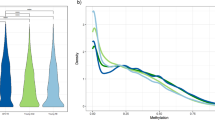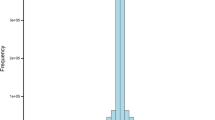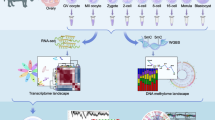Abstract
Blastomere biopsy is used in preimplantation genetic diagnosis; however, the long-term implications on the offspring are poorly characterized. We previously reported a high risk of memory defects in adult biopsied mice. Here, we assessed nervous function of aged biopsied mice and further investigated the mechanism of neural impairment after biopsy. We found that aged biopsied mice had poorer spatial learning ability, increased neuron degeneration, and altered expression of proteins involved in neural degeneration or dysfunction in the brain compared to aged control mice. Furthermore, the MeDIP assay indicated a genome-wide low methylation in the brains of adult biopsied mice when compared to the controls, and most of the genes containing differentially methylated loci in promoter regions were associated with neural disorders. When we further compared the genomic DNA methylation profiles of 7.5-days postconception (dpc) embryos between the biopsy and control group, we found the whole genome low methylation in the biopsied group, suggesting that blastomere biopsy was an obstacle to de novo methylation during early embryo development. Further analysis on mRNA profiles of 4.5-dpc embryos indicated that reduced expression of de novo methylation genes in biopsied embryos may impact de novo methylation. In conclusion, we demonstrate an abnormal neural development and function in mice generated after blastomere biopsy. The impaired epigenetic reprogramming during early embryo development may be the latent mechanism contributing to the impairment of the nervous system in the biopsied mice, which results in a hypomethylation status in their brains.






Similar content being viewed by others
References
Ecker DJ, Stein P, Xu Z, Williams CJ, Kopf GS, Bilker WB, Abel T, Schultz RM (2004) Long-term effects of culture of preimplantation mouse embryos on behavior. Proc Natl Acad Sci USA 101(6):1595–1600
Wilson CL, Fisher JR, Hammarberg K, Amor DJ, Halliday JL (2011) Looking downstream: a review of the literature on physical and psychosocial health outcomes in adolescents and young adults who were conceived by ART. Hum Reprod 26(5):1209–1219
Maher ER (2005) Imprinting and assisted reproductive technology. Hum Mol Genet 14:R133–R138
Watkins AJ, Platt D, Papenbrock T, Wilkins A, Eckert JJ, Kwong WY, Osmond C, Hanson M, Fleming TP (2007) From the cover: mouse embryo culture induces changes in postnatal phenotype including raised systolic blood pressure. Proc Natl Acad Sci USA 104(13):5449–5454
Hardy K, Martin KL, Leese HJ, Winston RM, Handyside AH (1990) Human preimplantation development in vitro is not adversely affected by biopsy at the 8-cell stage. Hum Reprod 5(6):708–714
Sermon K, Van Steirteghem A, Liebaers I (2004) Preimplantation genetic diagnosis. Lancet 363(9421):1633–1641
Moutou C, Viville S (2003) Preimplantation genetic diagnosis of monogenic diseases. Ann Biol Clin (Paris) 61(5):521–532
Desmyttere S, Bonduelle M, Nekkebroeck J, Roelants M, Liebaers I, De Schepper J (2009) Growth and health outcome of 102 2-year-old children conceived after preimplantation genetic diagnosis or screening. Early Hum Dev 85(12):755–759
Nekkebroeck J, Bonduelle M, Desmyttere S, Van den Broeck W, Ponjaert-Kristoffersen I (2008) Mental and psychomotor development of 2-year-old children born after preimplantation genetic diagnosis/screening. Hum Reprod 23(7):1560–1566
Banerjee I, Shevlin M, Taranissi M, Thornhill A, Abdalla H, Ozturk O, Barnes J, Sutcliffe A (2008) Health of children conceived after preimplantation genetic diagnosis: a preliminary outcome study. Reprod Biomed Online 16(3):376–381
Mastenbroek S, Twisk M, van der Veen F, Repping S (2011) Preimplantation genetic screening: a systematic review and meta-analysis of RCTs. Hum Reprod Update 17(4):454–466
Cho YJ, Kim JY, Song IO, Lee HS, Lim CK, Koong MK, Kang IS (2011) Does blastomere biopsy in preimplantation genetic diagnosis affect early serum beta-hCG levels? Clin Exp Reprod Med 38(1):31–36
Middelburg KJ, van der Heide M, Houtzager B, Jongbloed-Pereboom M, Fidler V, Bos AF, Kok J, Hadders-Algra M, PGS Follow-up Study Group (2011) Mental, psychomotor, neurologic, and behavioral outcomes of 2-year-old children born after preimplantation genetic screening: follow-up of a randomized controlled trial. Fertil Steril 96(1):165–169
Yu Y, Wu J, Fan Y, Lv Z, Guo X, Zhao C, Zhou R, Zhang Z, Wang F, Xiao M, Chen L, Zhu H, Chen W, Lin M, Liu J, Zhou Z, Wang L, Huo R, Zhou Q, Sha J (2009) Evaluation of blastomere biopsy using a mouse model indicates the potential high risk of neurodegenerative disorders in the offspring. Mol Cell Proteomics 8(7):1490–1500
Vorhees CV, Williams MT (2006) Morris water maze: procedures for assessing spatial and related forms of learning and memory. Nat Protoc 1(2):848–858
Ogawa N, Hirose Y, Ohara S, Ono T, Watanabe Y (1985) A simple quantitative bradykinesia test in MPTP-treated mice. Res Commun Chem Pathol Pharmacol 50(3):435–441
Zhu YF, Cui YG, Guo XJ, Wang L, Bi Y, Hu YQ, Zhao X, Liu Q, Huo R, Lin M, Zhou ZM, Sha JH (2006) Proteomic analysis of effect of hyperthermia on spermatogenesis in adult male mice. J Proteome Res 5(9):2217–2225
Scacheri P, Crawford GE, Davis S (2006) Statistics for ChIP-chip and DNase hypersensitivity experiments on NimbleGen arrays. Methods Enzymol 411:270–282
Han SY, Kim SH, Heasley LE (2002) Differential gene regulation by specific gain-of-function JNK1 proteins expressed in Swiss 3T3 fibroblasts. J Biol Chem 277(49):47167–47174
Maekawa M, Yamaguchi K, Nakamura T, Shibukawa R, Kodanaka I, Ichisaka T, Kawamura Y, Mochizuki H, Goshima N, Yamanaka S (2011) Direct reprogramming of somatic cells is promoted by maternal transcription factor Glis1. Nature 474(7350):225–229
Winston RM, Hardy K (2002) Are we ignoring potential dangers of in vitro fertilization and related treatments? Nat Cell Biol 4:s14–s18
von Bernhardi R, Tichauer JE, Eugenin J (2010) Aging-dependent changes of microglial cells and their relevance for neurodegenerative disorders. J Neurochem 112(5):1099–1114
Logue SF, Paylor R, Wehner JM (1997) Hippocampal lesions cause learning deficits in inbred mice in the Morris water maze and conditioned-fear task. Behav Neurosci 111(1):104–113
Morris RG, Garrud P, Rawlins JN, O’Keefe J (1982) Place navigation impaired in rats with hippocampal lesions. Nature 297(5868):681–683
Scheff SW, Price DA, Schmitt FA, Mufson EJ (2006) Hippocampal synaptic loss in early Alzheimer’s disease and mild cognitive impairment. Neurobiol Aging 27(10):1372–1384
Niwa J, Yamada S, Ishigaki S, Sone J, Takahashi M, Katsuno M, Tanaka F, Doyu M, Sobue G (2007) Disulfide bond mediates aggregation, toxicity, and ubiquitylation of familial amyotrophic lateral sclerosis-linked mutant SOD1. J Biol Chem 282(38):28087–28095
Magrane J, Hervias I, Henning MS, Damiano M, Kawamata H, Manfredi G (2009) Mutant SOD1 in neuronal mitochondria causes toxicity and mitochondrial dynamics abnormalities. Hum Mol Genet 18(23):4552–4564
Yum SW, Zhang J, Mo K, Li J, Scherer SS (2009) A novel recessive Nefl mutation causes a severe, early-onset axonal neuropathy. Ann Neurol 66(6):759–770
Suzuki Y, Nakagomi S, Namikawa K, Kiryu-Seo S, Inagaki N, Kaibuchi K, Aizawa H, Kikuchi K, Kiyama H (2003) Collapsin response mediator protein-2 accelerates axon regeneration of nerve-injured motor neurons of rat. J Neurochem 86(4):1042–1050
Picklo MJ, Olson SJ, Markesbery WR, Montine TJ (2001) Expression and activities of aldo-keto oxidoreductases in Alzheimer disease. J Neuropathol Exp Neurol 60(7):686–695
Manipalviratn S, DeCherney A, Segars J (2009) Imprinting disorders and assisted reproductive technology. Fertil Steril 91(2):305–315
Amor DJ, Halliday J (2008) A review of known imprinting syndromes and their association with assisted reproduction technologies. Hum Reprod 23(12):2826–2834
Market-Velker BA, Zhang L, Magri LS, Bonvissuto AC, Mann MR (2010) Dual effects of superovulation: loss of maternal and paternal imprinted methylation in a dose-dependent manner. Hum Mol Genet 19(1):36–51
Market-Velker BA, Fernandes AD, Mann MR (2010) Side-by-side comparison of five commercial media systems in a mouse model: suboptimal in vitro culture interferes with imprint maintenance. Biol Reprod 83(6):938–950
van Montfoort AP, Hanssen LL, de Sutter P, Viville S, Geraedts JP, de Boer P (2012) Assisted reproduction treatment and epigenetic inheritance. Hum Reprod Update 18(2):171–197
Mager GM, Ward RM, Srinivasan R, Jang SW, Wrabetz L, Svaren J (2008) Active gene repression by the Egr2.NAB complex during peripheral nerve myelination. J Biol Chem 283(26):18187–18197
Srinivasan R, Mager GM, Ward RM, Mayer J, Svaren J (2006) NAB2 represses transcription by interacting with the CHD4 subunit of the nucleosome remodeling and deacetylase (NuRD) complex. J Biol Chem 281(22):15129–15137
Griffiths IR, Scott I, McCulloch MC, Barrie JA, McPhilemy K, Cattanach BM (1990) Rumpshaker mouse: a new X-linked mutation affecting myelination: evidence for a defect in PLP expression. J Neurocytol 19(2):273–283
Al-Saktawi K, McLaughlin M, Klugmann M, Schneider A, Barrie JA, McCulloch MC, Montague P, Kirkham D, Nave KA, Griffiths IR (2003) Genetic background determines phenotypic severity of the Plp rumpshaker mutation. J Neurosci Res 72(1):12–24
Santos F, Hendrich B, Reik W, Dean W (2002) Dynamic reprogramming of DNA methylation in the early mouse embryo. Dev Biol 241(1):172–182
Borgel J, Guibert S, Li Y, Chiba H, Schübeler D, Sasaki H, Forné T, Weber M (2010) Targets and dynamics of promoter DNA methylation during early mouse development. Nat Genet 42(12):1093–1100
Leung DC, Dong KB, Maksakova IA, Goyal P, Appanah R, Lee S, Tachibana M, Shinkai Y, Lehnertz B, Mager DL, Rossi F, Lorincz MC (2011) Lysine methyltransferase G9a is required for de novo DNA methylation and the establishment, but not the maintenance, of proviral silencing. Proc Natl Acad Sci USA 108(14):5718–5723
Shamay M, Greenway M, Liao G, Ambinder RF, Hayward SD (2010) De novo DNA methyltransferase DNMT3b interacts with NEDD8-modified proteins. J Biol Chem 285(47):36377–36386
Jepsen K, Solum D, Zhou T, McEvilly RJ, Kim HJ, Glass CK, Hermanson O, Rosenfeld MG (2007) SMRT-mediated repression of an H3K27 demethylase in progression from neural stem cell to neuron. Nature 450(7168):415–419
Kawakami Y, Yoshida K, Yang JH, Suzuki T, Azuma N, Sakai K, Hashikawa T, Watanabe M, Yasuda K, Kuhara S, Hirabayashi Y, Furuya S (2009) Impaired neurogenesis in embryonic spinal cord of Phgdh knockout mice, a serine deficiency disorder model. Neurosci Res 63(3):184–193
Acknowledgments
We thank Ming Xiao for his technical support during the experiment of brain morphological analysis. We thank Xuejiang Guo for help with the proteomics data analysis. This study was supported by grants from the Major State Basic Research Development Program of China (973 Program) (No. 2012CB944902) and from the National Science Foundation of China (No.31271604).
Author information
Authors and Affiliations
Corresponding authors
Additional information
Y. Wu, Z. Lv, and Y. Yang contributed equally to this work.
Electronic supplementary material
Below is the link to the electronic supplementary material.
Rights and permissions
About this article
Cite this article
Wu, Y., Lv, Z., Yang, Y. et al. Blastomere biopsy influences epigenetic reprogramming during early embryo development, which impacts neural development and function in resulting mice. Cell. Mol. Life Sci. 71, 1761–1774 (2014). https://doi.org/10.1007/s00018-013-1466-2
Received:
Revised:
Accepted:
Published:
Issue Date:
DOI: https://doi.org/10.1007/s00018-013-1466-2




